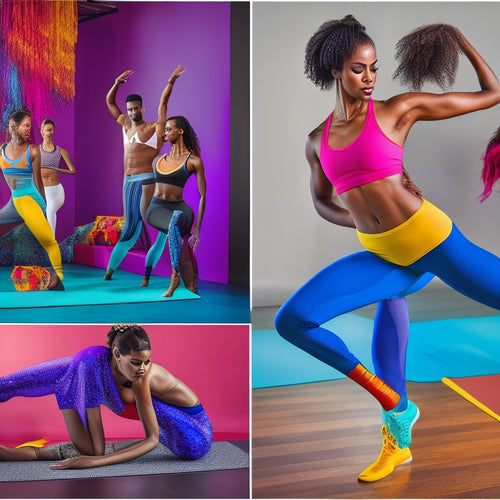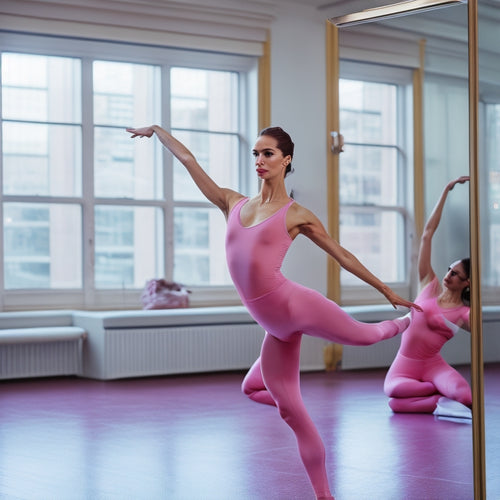
3 Best Hip-Opening Exercises for Pain-Free Movement
Share
You can greatly improve your overall mobility and reduce stiffness by incorporating targeted exercises that release tension in your hip flexors, strengthen your hip girdle muscles, and enhance your range of motion. Start by releasing tension in your psoas muscle, which can limit your range of motion, and engage your hip girdle muscles for stability. Then, try exercises that target your gluteus medius, gluteus maximus, and tensor fasciae latae muscles. Finally, incorporate dynamic stretching to enhance your hip flexibility. As you explore these exercises, you'll discover a new level of flexibility and mobility that will leave you feeling more confident and pain-free in your movements.
Key Takeaways
• Releasing tension in the hips, particularly in the psoas muscle, can reduce lower back pain and sciatica discomfort.
• Engaging in dynamic stretching exercises, like leg swings and hip circles, can increase flexibility and range of motion.
• Practicing mindful walking with a relaxed hip and neutral pelvis can improve posture and reduce stiffness.
• Strengthening the hip girdle muscles can enhance athletic performance, prevent muscle imbalance, and reduce injury risk.
• Unlocking hip flexibility can improve overall mobility, enhance posture, and reduce stiffness, leading to pain-free movement.
Unlocking Hip Flexibility With Movement
By incorporating specific exercises into your daily routine, you can release tight hip flexors and discover a new level of flexibility and range of motion. As you move through your day, you'll notice improved posture, reduced stiffness, and enhanced overall mobility.
One effective way to enhance hip flexibility is through Dynamic Stretching. This type of stretching involves moving your joints through a range of motion while keeping your muscles active. Examples of dynamic stretches for the hips include leg swings, hip circles, and high knees. By incorporating these exercises into your daily routine, you can increase flexibility, reduce stiffness, and improve your overall range of motion.
Another way to encourage hip flexibility is through Mindful Walking. By paying attention to your gait, posture, and stride, you can identify areas of tension and make adjustments to release tightness in the hips. As you walk, focus on keeping your hips relaxed, your pelvis neutral, and your feet striking the ground midfoot or forefoot.
Releasing Tension in the Hips
As you focus on releasing tension in your hips, you'll want to target the psoas muscle, a deep-seated hip flexor that, when tight, can limit your range of motion and cause discomfort. This muscle isn't only physical but also emotional, as it's often linked to emotional blockages such as fear, anxiety, and stress.
When the psoas muscle is tight, it can affect your pelvic alignment, leading to poor posture, lower back pain, and even sciatica.
To release tension in your hips, start by lying on your back with your knees bent and feet flat on the floor. Place your fingers on your lower abdomen, just above the pubic bone, and gently press inward and upward. Hold for 30 seconds and release. Repeat this process several times, focusing on relaxing your psoas muscle with each breath.
As you release physical tension, you may also notice a sense of emotional release, allowing you to move with more ease and freedom. By releasing tension in your hips, you'll improve your pelvic alignment, reduce discomfort, and enhance your overall movement.
Strengthening the Hip Girdle Muscles
Now that you've released tension in your hips, it's time to engage your hip girdle muscles, which play an essential role in stabilizing your pelvis and facilitating smooth, powerful movement.
Weak or imbalanced hip girdle muscles can lead to muscle imbalance, putting unnecessary strain on your joints and increasing your risk of injury. By strengthening these muscles, you'll improve pelvic stability, reduce your risk of injury, and enhance your overall athletic performance.
Focus on exercises that target your gluteus medius, gluteus maximus, and tensor fasciae latae muscles. These muscles work together to stabilize your pelvis and facilitate hip movement. Try exercises like side-lying leg lifts, clamshell exercises, and step-ups to engage these muscles.
Start with lower reps and sets and gradually increase the difficulty as your muscles strengthen. Remember to listen to your body and avoid any exercises that cause pain or discomfort.
With consistent practice, you'll develop strong, stable hips that will help you move with confidence and precision.
Frequently Asked Questions
Can I Do Hip-Opening Exercises if I Have a Hip Replacement?
'If you've had a hip replacement, it's essential you get your surgeon's advice before attempting hip-opening exercises to avoid compromising your artificial joint. Don't risk disrupting the artificial constraints, consult first for a safe, personalized approach.'
How Often Should I Stretch My Hips for Optimal Flexibility?
'For best flexibility, you should aim to stretch your hips 2-3 times a week, with daily routine consistency matters; incorporate short sessions into your daily routine to maintain flexibility and reduce stiffness.'
Can Hip-Opening Exercises Help With Sciatica Pain Relief?
"You're tired of living with sciatica pain, but can hip-opening exercises really bring relief? Absolutely! By increasing muscle relaxation and improving pain management, these exercises can help alleviate sciatica discomfort, giving you a chance to reclaim your active lifestyle."
Are Hip-Opening Exercises Suitable for Pregnant or Postpartum Women?
As a pregnant or postpartum woman, you'll benefit from modified hip-opening exercises that accommodate your body changes, hormonal fluctuations, and pelvic floor considerations, while also strengthening your core to support your changing body.
Can I Do Hip-Opening Exercises if I Have Hip Osteoporosis?
If you have hip osteoporosis, it's crucial to approach hip-opening exercises with caution, considering your bone density and fragility concerns; consult your doctor or a qualified fitness expert to modify exercises and establish a safe, adapted routine.
Related Posts
-

What Contemporary Dancewear Essentials Do Dancers Need
As a contemporary dancer, you need essentials that enhance your flexibility and creativity. Opt for high-waisted legg...
-

Dance Practice Wear Picks for Maximum Comfort and Performance
When choosing dance practice wear, you want gear that optimizes comfort and performance. Opt for moisture-wicking fab...
-

Elder Hall Hosts Bird Dance Extravaganza
On March 1, 2024, Elder Hall will come alive with the 'Dancing with the Birds' event, a mesmerizing fusion of music, ...


